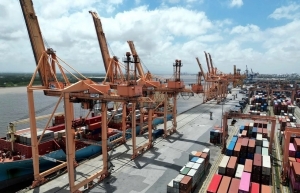Domestic exports continue to flourish
 |
Bui Huy Son, director of the Department of Planning and Finance, said that the export turnover in the first half of the year was estimated at $188.97 billion, up 13.8 per cent on year.
The main export group is the processing and manufacturing industry, estimated at almost $160 billion, accounting for 84.63 per cent of total export turnover.
Agricultural products continue to be a bright spot in export growth, increasing by 18.8 per cent on year (that in the same period last year decreased by 2.3 per cent), total export turnover is estimated at $18.21 billion in the first half of 2024.
Fruits and vegetables in the first half of 2024 reached $3.4 billion, up 28 per cent on year. Durian, dragon fruit, banana, and longan have greatly contributed to fruit and vegetable export growth.
Also, according to the MoIT, in the first half of the year, the total import-export turnover is estimated at nearly $370 billion, up 16 per cent on year. The trade balance continues to be in surplus at $8.4 billion.
Nguyen Duc Hung Linh, consulting director of Think Future Consultancy, said that thanks to the recovery of exports, Vietnam's GDP in the first quarter of 2024 increased to 5.66 per cent (compared to an increase of 3.32 per cent in the first quarter of 2023).
The number of applications for unemployment benefits in the first quarter of 2024 also decreased to 168,000, the lowest number in 10 quarters, reflecting the improvement in the employment sector and business activities of enterprises.
The openness of Vietnam's economy is large. According to the World Bank, Vietnam's export value of goods and services is equivalent to 94 per cent of GDP, ranking 14th in the world.
Of Vietnam's total exports, goods exports account for 82 per cent of GDP. Service exports, mainly tourism and transport, account for 12 per cent of GDP. Two other important components of economic growth are retail sales of goods and services and investment, including private investment, public investment, and foreign direct investment (FDI), accounting for only 61 and 33 per cent of GDP, respectively.
Exports are the direct driving force and makes the biggest impact on Vietnam's economic growth. Linh said, "In 2018 and 2019, Vietnam reported GDP growth of over 7 per cent, the highest level over the last 10 years. Exports in these years increased by 13.2 and 8.4 per cent, respectively. In 2023, when exports decreased by 4.6 per cent, GDP only reached 5 per cent."
As the most important driving force of the economy, Vietnam's exports are greatly dependent on the needs of developed economies. Currently, the United States, EU, South Korea, and Japan account for 53 per cent of Vietnam's export value. The decline in exports to these markets has reduced total exports and slowed down Vietnam's economic growth. In 2023, exports to the US dropped by 11.3 per cent, the EU decreased by 6.7 per cent, both South Korea and Japan went down by 3.7 per cent.
In 2024, developed economies are regaining positive growth momentum, which is forecast to grow at 1.7 per cent in 2024 and 1.8 per cent in 2025 (compared to 1.6 per cent in 2023). The World Trade Organization predicts that global goods trade will increase by 2.6 and 3.3 per cent in 2024 and 2025, respectively, after decreasing by 1.2 per cent in 2023.
Improved purchasing power in developed countries has impacted Vietnam's economy. Exports of goods in the first five months of 2024 increased by 15.2 per cent, while that in the same period in 2023 decreased by 11.7 per cent. Exports to the US, EU, South Korea and Japan returned to growing well, reaching 22.3, 16.1, 10.9, and 3.2 per cent, respectively.
In addition to positive signs, economic experts say that import-export activities are growing well but still face many challenges because increased export turnover contributed to the rise in prices (especially agricultural products and energy), the raise in transportation costs, and price increases of USD.
Moreover, import and export activities continue to depend on some markets, products and FDI. Some key export products of Vietnam to major markets continue being at risk from trade defence investigations and related technical barriers related to the environment, sustainable development, and green transformation.
In the second half of 2024, the MoIT believes that imports and exports will be favourable as existing free trade agreements continue to have a positive impact, maintaining Vietnam's advantage in trade, and investment activities. But the global economy is entering a new period with many risks, challenges, and unpredictability, increasing competition in Vietnam's chief export markets.
 | FTA quality improvement promotes exports: Experts Enhancing the quality of the 16 free trade agreements (FTA) that Vietnam has signed with partners will be a helpful measure to aid domestic firms in facilitating exports in the coming time, according to experts. |
 | ESG is vital for exporters Businesses, especially exporters, must embrace environmental, social, and governance (ESG) policies or face losing out on trade, according to Nguyen Dinh Tho, general director of the Institute of Strategy and Policy on Natural Resources and Environment (ISPONRE). |
 | Shipping costs continue to climb Rising logistics costs are eroding profits and forcing exporters to freeze orders, as well as revealing inadequacies in the management of foreign shipping companies operating in the waters of Vietnam. |
 | Trade sector encouraged to go green Vietnam is facing great pressure in greening its exports as consumers are paying bigger heed to environmentally friendly products, while advantages from free trade agreements are not being fully taken for the country to expand its offerings. |
What the stars mean:
★ Poor ★ ★ Promising ★★★ Good ★★★★ Very good ★★★★★ Exceptional
 Tag:
Tag:
Related Contents
Latest News
More News
- Double-digit GDP growth within reach with shift to higher-value expansion (January 06, 2026 | 08:33)
- Takeda Vietnam awarded for ongoing support of Vietnam’s sustainability efforts (December 31, 2025 | 21:00)
- Vietnam's retail market tops $269 billion in 2025 amid e-commerce boom (December 31, 2025 | 19:00)
- Stronger legal framework urged as trade fraud surges online (December 31, 2025 | 18:58)
- FPT exports first chip shipment to Japan (December 31, 2025 | 10:47)
- AkzoNobel rolls out sustainability campaign “It All Adds Up” for the wood sector (December 31, 2025 | 09:23)
- Textile apparel firms deliver robust earnings despite global tariff pressures (December 30, 2025 | 10:09)
- Businesses ramp up production as year-end orders surge (December 30, 2025 | 10:05)
- Vietjet chairwoman awarded Labour Hero title (December 29, 2025 | 13:06)
- How to unlock ESG value through green innovation (December 29, 2025 | 10:03)



























 Mobile Version
Mobile Version